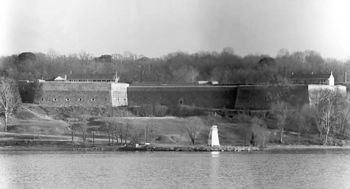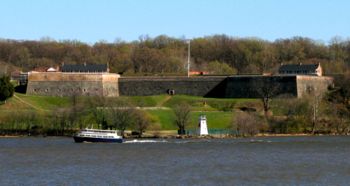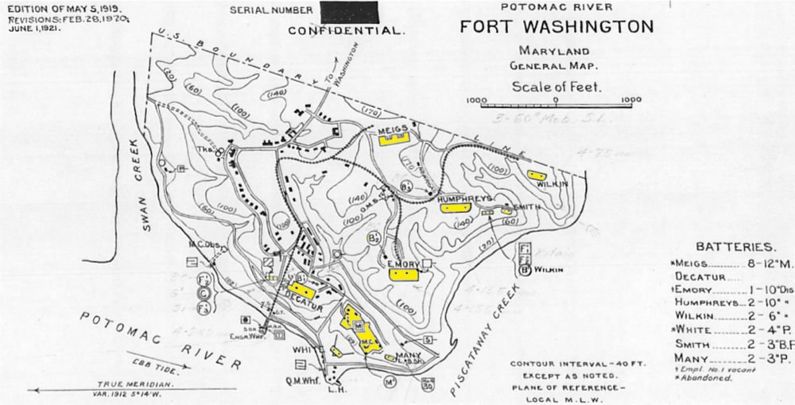Fort Washington (1)
|
Fort Washington (1) (1809-1946) - Established in 1808 as Fort Warburton and later rebuilt and named as Fort Washington after General George Washington, first President of the United States. Fort Washington was a transitional fortification encompassing parts of Second, Third and Endicott period fortifications. Returned to the Interior Department in 1946.
 
Fort Washington (1) HistoryFort Warburton was completed in 1809 and guarded the Nation’s Capital until it was blown up by its own garrison in 1814 as the British Fleet advanced up the Potomac. Twelve days later Major Pierre L’Enfant was sent to construct new defenses but worked on the fort for only a brief period before Lieutenant Colonel Walker K. Armistead (Cullum 3) replaced him. The fort was completed on October 2, 1824. Extensive remodeling was performed in the 1840s and the first guns were mounted in 1846. The masonry fort was occupied by soldiers from the 1st U.S. Artillery, 3rd U.S. Artillery and 4th U.S. Artillery during its early history. U.S. Civil War (1861-1865)Except for a few guns at the Washington Arsenal, Fort Washington was the only defense for the Nation’s Capital until the Civil War when a circle of temporary forts was built around the city. Battery Rodgers and Fort Foote (1) were the only seacoast forts in the system and armed with large Rodman and Parrott cannons. Fort Washington was garrisoned as the outer defense for the city. Companies of the 1st U.S. Artillery and 4th U.S. Artillery as well as numerous state artillery units passed through the post during the war. In 1872 the garrison was removed and additional property purchased to construct a new defense system. Funds for the project was withdrawn and the post was abandoned for the next twenty years. Endicott Period (1890-1910)Part of the Harbor Defense of the Potomac. A new defense system, consisting of rifled steel guns in concrete emplacements was authorized in 1886 and work began at Fort Washington in 1891. The next year ground was broken for Battery B, later named Battery Decatur but work was suspended on this battery until development of a disappearing carriage for 10" guns was complete. Work resumed in 1896 on Battery Decatur and later on three other similar batteries. On 6 Jul 1899 Battery Decatur, Battery Emory, Battery Humphreys (2) and Battery White (1) were accepted for service. In 1902 Battery Meigs was accepted for service as a 12" mortar battery with eight mortars. All in all, eight Endicott Period batteries were built and accepted at Fort Washington between 1896 and 1905. Advances in shipboard armament soon made the defenses at Fort Washington obsolete. Enemy ships could shell Washington D.C. while still out of range of Fort Washington's guns.

World War I (1917-1918)Prior to the U.S. entry into World War I Fort Washington was downgraded to harbor defense and the large mortars were removed. During the war the post was used as a staging area for troops being sent to France. Many of the larger caliber guns were removed and shipped overseas or to other higher priority areas. The 8th Provisional Artillery Battalion was organized at the post and sent to France where they became the 53rd Railroad Artillery Regiment. After the war the 3rd Battalion 12th Infantry moved in and became the ceremonial unit for the Military District of Washington. All of the Endicott Period batteries were inactive by the end of 1930. World War II (1941-1945)In 1939 the post was abandoned and turned over to the Director of Public Buildings for use as a terminal point for a bridge across the Potomac and a parkway to be built along the shore. Before the transfer was complete the United States entered World War II. Fort Washington was returned to the army and became the home of the Adjutant General’s School. After the war the Veterans Administration managed the post hospital and other government agencies occupied some of the buildings. In 1946 Fort Washington returned to the Department of the Interior.
Current StatusNational Park. Some period guns and carriages carriages remain in the old fort but no Endicott Period guns and carriages are in place. Blog Posts:
See Also: Sources:
Links:
Visited: 4 Apr 2009 Picture Gallery
| ||||||||||||||||||||||||||||||||||||||||||||||||||||||||||||||||||||||||||||||||||||||||||||||||||
- Harbor Defense of the Potomac
- Visited
- All
- Maryland Forts
- Maryland All
- Maryland Prince George's County
- Endicott Period Forts
- Second System Forts
- Third System Forts
- World War I Forts
- World War I Coastal Forts
- World War II Forts
- Coastal Forts
- Washington DC Defense System - U.S. Civil War
- Preserved
- National Park
- Must See
- Fort Washington (1)
- U.S. Civil War Forts
- 2009 CDSG Meeting



